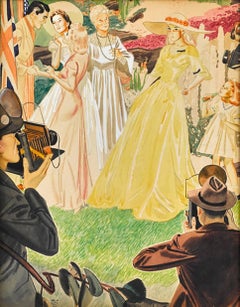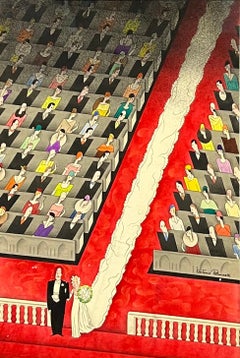John Holmgren Art
to
1
1
Overall Width
to
Overall Height
to
2
1
1
1
2
2
2
1
1
1
1
2
2
2
1
1
2
8,228
2,805
1,654
1,315
2
2
Artist: John Holmgren
A Christmas Number, Judge Magazine Cover
By John Holmgren
Located in Fort Washington, PA
Signature: light pencil signature lower left in the artwork
Front Cover Art Judge Magazine December 1933
In a departure from their typical flapper cov...
Category
1930s John Holmgren Art
Materials
Gouache, Illustration Board
Photoshoot in the Park
By John Holmgren
Located in Fort Washington, PA
Medium: Watercolor and Gouache
Dimensions: 13.50" x 10.50"
Signature: Signed Lower Left
Category
Early 20th Century John Holmgren Art
Materials
Watercolor, Gouache
Related Items
Original Painting. Colliers Magazine Cover Published 1933 Wedding Illustration
By Antonio Petruccelli
Located in New York, NY
Original Painting. Colliers Magazine Cover Published 1933 Wedding Illustration
Antonio Petruccelli (1907 - 1994)
The Wedding
Colliers published, June 17, 1933
17 1/4 X 11 1/2 inches (sight)
Framed 23 1/4 X 17 1/2 inches
Gouache on board
Signed lower right
BIOGRAPHY:
Antonio Petruccelli (1907-1994) began his career as a textile designer. He became a freelance illustrator in 1932 after winning several House Beautiful cover illustration contests.
In addition to 24 Fortune magazine covers, four New Yorker covers, several for House Beautiful, Collier’s, and other magazines he did numerous illustrations for Life magazine from the 1930s – 60s.
‘Tony was Mr. Versatility for Fortune. He could do anything, from charts and diagrams to maps, illustrations, covers, and caricatures,’ said Francis Brennan, the former art director for Fortune.
Over the course of his career, Antonio won several important design awards, designing a U.S. Postage Stamp Commemorating the Steel Industry and designing the Bicentennial Medal...
Category
1930s American Realist John Holmgren Art
Materials
Gouache, Board
"Workers" Russian Constructivist 1920s Modern Social Realism Cubism Figurative
Located in New York, NY
"Workers" Russian Constructivist 1920s Modern Social Realism Cubism Figurative
VLADIMIR VASIL’EVICH LEBEDEV (1891-1967)
"Workers"
Gouache on paper
Monog...
Category
1920s Constructivist John Holmgren Art
Materials
Paper, Gouache
Art Deco Couple Portrait
Located in Wilton Manors, FL
Beautiful Art Deco illustration by unknown artist.
Ink and gouache on faux wood grain illustration board.
Image field measuring 14 x 18 inches on a 17 x 21 inch illustration panel...
Category
Early 20th Century Art Deco John Holmgren Art
Materials
Ink, Gouache, Illustration Board
"Skipper's Orders" (2023) By Judd Mercer, Original Impressionist Lake Scene
By Judd Mercer
Located in Denver, CO
"Skipper's Orders" is a beautiful original impressionist lakeside scene, depicting a family rigging a boat in the afternoon, on the lakeshore under the shade of an Oak tree.
Judd Me...
Category
2010s Impressionist John Holmgren Art
Materials
Gouache
$350
H 5 in W 7 in D 0.2 in
Old City Jerusalem City Walls landscape Scene Painting, Judaica
By Jossi Stern
Located in Surfside, FL
Vibrant Gouache and watercolor painting by Israeli master JOSSI STERN. on paper mounted to board.
Dimensions: 29.5 X 33.5 23 X 27
Jossi (Yossi) Stern, (Hungarian Israeli 1923 - ...
Category
20th Century Modern John Holmgren Art
Materials
Watercolor, Gouache, Illustration Board
Vintage Bi-Plane Watercolor
Located in San Francisco, CA
Vintage bi-plane
Category
20th Century John Holmgren Art
Materials
Watercolor, Illustration Board
Sunshine I - Modern Luminous Yellow Folk Art Inspired Painting on Raw Canvas
Located in Los Angeles, CA
Meredith Walker’s "Sunshine I" is a luminous fusion of contemporary folk art, naïve surrealism, and symbolic illustration, embodying a tender balance between emotional vulnerability ...
Category
2010s Contemporary John Holmgren Art
Materials
Canvas, Acrylic, Gouache
Late 19th Century Original English Landscape of a Cottage in Cambria
Located in Soquel, CA
Late 19th Century Original English Landscape of a Cottage in Cambria
Wonderful original antique painting of a thatched cottage in Cambria by...
Category
1880s Impressionist John Holmgren Art
Materials
Illustration Board, Gouache
$1,650
H 10.5 in W 13.5 in D 2 in
Original Painting. New Yorker Mag Cover Proposal WPA Mid Century American Scene
By Antonio Petruccelli
Located in New York, NY
Original Painting. New Yorker Mag Cover Proposal WPA Mid Century American Scene
Antonio Petruccelli (1907 – 1994)
Perplexed Gentleman
New Yorker cover proposal, c. 1939
13 1/4 X 8 ...
Category
1930s American Modern John Holmgren Art
Materials
Gouache, Board
Antique Illustration of a Golfer by Listed Illustrator for Vanity Fair
Located in Buffalo, NY
Antique illustration of a golfer getting out of a sand trap by well listed illustrator Leslie Saalburg whose work appeared in Vanity Fair and Esquire.
Category
1910s Realist John Holmgren Art
Materials
Gouache, Illustration Board
$871 Sale Price
56% Off
H 21 in W 16 in D 0.5 in
Sunshine II - Modern Luminous Yellow Folk Art Inspired Painting on Raw Canvas
Located in Los Angeles, CA
Meredith Walker’s "Sunshine II" is a luminous fusion of contemporary folk art, naïve surrealism, and symbolic illustration, embodying a tender balance between emotional vulnerability...
Category
2010s Contemporary John Holmgren Art
Materials
Canvas, Acrylic, Gouache
Original Painting. New Yorker Magazine Published 1935 American Scene Modern WPA
By Antonio Petruccelli
Located in New York, NY
Original Painting. New Yorker Magazine Published 1935 American Scene Modern WPA
Antonio Petruccelli (1907 - 1994)
Movers
New Yorker published, September 20, 1935
18 X 11 1/2 inches...
Category
1930s American Realist John Holmgren Art
Materials
Gouache, Board
John Holmgren art for sale on 1stDibs.
Find a wide variety of authentic John Holmgren art available for sale on 1stDibs. You can also browse by medium to find art by John Holmgren in gouache, paint, watercolor and more. Not every interior allows for large John Holmgren art, so small editions measuring 5 inches across are available. Customers who are interested in this artist might also find the work of Thelma Terrell, Frederick Coffay Yohn, and Walter G. Ratterman. John Holmgren art prices can differ depending upon medium, time period and other attributes. On 1stDibs, the price for these items starts at $2,900 and tops out at $3,900, while the average work can sell for $3,400.



